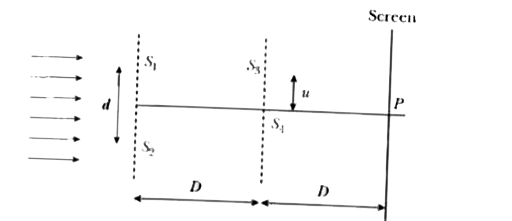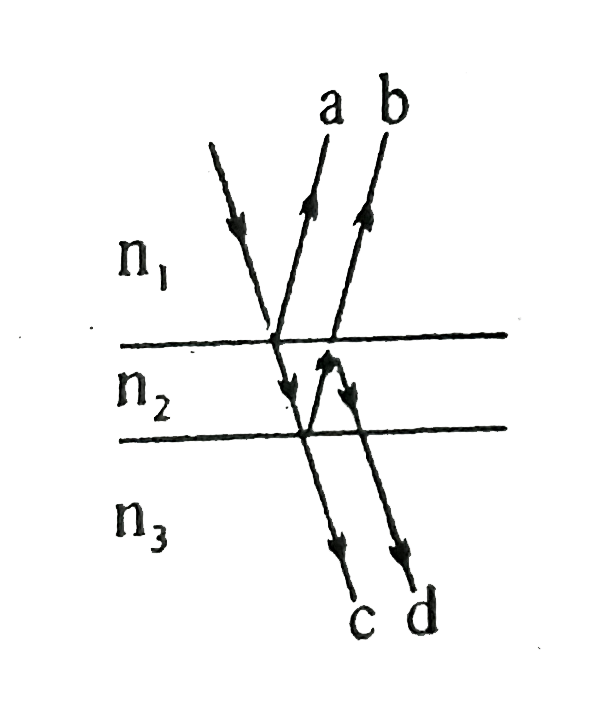The figure shows four situations in which light reflects perpendicularly from a thin film of thickness L, with indexes of refraction as given. (a) For which situations does reflection at the film interfaces cause a zero phase difference for the two reflected rays? (b) For which situations will the film be dark if the path length difference 2L causes a phase difference of 0.5 wavelength?

(a) 1 and 4, (b) 1 and 4
Topper's Solved these Questions
- INTERFERENCE AND DIFFRACTION BOOK - RESNICK AND HALLIDAYCHAPTER - INTERFERENCE AND DIFFRACTION EXERCISE - PROBLEMS
61 Videos
- INTERFERENCE AND DIFFRACTION BOOK - RESNICK AND HALLIDAYCHAPTER - INTERFERENCE AND DIFFRACTION EXERCISE - PRACTICE QUESTIONS (Single Correct Choice Type)
66 Videos
- INTERFERENCE AND DIFFRACTION BOOK - RESNICK AND HALLIDAYCHAPTER - INTERFERENCE AND DIFFRACTION EXERCISE - PRACTICE QUESTIONS (Integer Type)
6 Videos
- HYDROGEN ATOMBOOK - RESNICK AND HALLIDAYCHAPTER - HYDROGEN ATOMEXERCISE - PRACTICE QUESTIONS(Integer Type)
6 Videos
- MAGNETIC FIELDS DUE TO CURRENTSBOOK - RESNICK AND HALLIDAYCHAPTER - MAGNETIC FIELDS DUE TO CURRENTSEXERCISE - Practice Question (Integer Type)
4 Videos
Similar Questions

In Figure, a broad bcam Incident light of light of wavelength 630 nn is sent directly downward through the top plate of a pair of glass plates touching at the left end. The air between the plates acts as a thin film, and an interference pattern can be seen from above the plates. Initially, a dark fringe lies at the left end, a bright fringe lies at the right end, and nine dark fringes lie between those two end fringes. The plates are then very gradually squeezed together at a constant rate to decrease the angle between them. As a result, the fringe at the right side changes between being bright to being dark every 15.0 s. (a) At what rate is the spacing between the plates at the right end being changed? (b) By how inuch has the spacing there changed when both left and right ends have a dark fringe and there are five dark fringes between them?
View SolutionThe intensity ratio of the two interfering beams of light is m. What is the value of Imax−Imin/Imax+Imin?
View SolutionIn the arrangement shown in the following figure, the wavelength of light used is λ. The distance between slits S1 and S2 is d (« D). The distance between S3 and S4 is u=λD/3d. If the ratio of maximum to minimum intensity observed on screen is k. Find k.

View SolutionThe radius of hydrogen atom in its ground state is 5.3×10−11m. After collision with an electron, it is found to have a radius of 21.2×10−11m. What is the principal quantum number of the final state of the atom?
View SolutionA steady current I goes through a wire loop PQR having shape of a right angle triangle with PQ=3x,PR=4xandQR=5x. If the magnitude of the magnetic field at P due to this loop is k(μ0I48πx), find the value of K.
View SolutionFind the minimum thcknessof a film which will strongly reflect the light of wavelength 589 nm. The refractive index of the material of the film is 1.25.
View SolutionA thin uniform film of refractive index 1.75 is placed on a sheet of glass of refractive index 1.5. At room temperature (20∘C) this film is just thick enoungh for light with wavelength 600 nm reflected off the top of the film to be canceled by light reflected from the top the glass. After the glass is placed in on oven and slowly heated to 170∘C, the film conceals reflected light with wavelength 606 nm. The coefficient of linear expansion of the film is (ignore any changes in the refractive index of the film due to the temperature change)
View SolutionA light of wavelength 5890Å falls normally on a thin air film. The minimum thickness of the film such that the film appears dark in reflected light is
View SolutionA ray of light is incident on a thin film Two of the reflected rays are shown, and two of the transmitted rays are shown in figure. Consider phase difference by comparing them with the phase of incident ray on the film. Match statements about phase difference in column-I with the correct order of refractive indices in column -II

Column-IColumn-II(A)Rays a and b have an extra phase difference overand above that due to extra optical path caused by reflection at various interfaces(P)n1>n2>n3(B)Rays a and c have an extra phase difference overand above that due to extra optical path caused by reflection at various interfaces(Q)n2>n3>n1(C)Rays a and d have an extra phase difference overand above that due to extra optical path caused by reflection at various interfaces(R)n3>n2>n1(D)Rays b and c have an extra phase difference overand above that due to extra optical path caused by reflection at various interfaces(S)n1=n3>n2(T)the specified extra phase difference is not possible
View SolutionStatement -1: If an exceedingly thin soap film is seen in reflected light, it may appear dark Statement -2 : Three is a phase difference of pi from the rays reflected from front and rear faces of the film.
View SolutionWhat is the minimum thickness of thin film required for constructive interference in the reflected light through it ?
(Given, the refractive index of the film =1.5, wavelength of the lilght incident on the film =600 nm.
View SolutionWhite light is incident on a soap film at an angle of 60^@ . On examining the reflecting light by a spectroscope, a dark band corresponding to wavelength 6200Å is found. Find the minimum thickness of the film. Take refractive index of film = 1.33.
View SolutionWhat is the minimum thickness of a thin film required for constructive interference in the reflected light from it? Given, the refractive index of the film = 1.5, wavelength of the light incident on the film = 600nm
View SolutionWhat is the minimum thickness of a thin film required for constructive interference in the reflected light from it ? Give, the refractive index of the film = 1.5 wavelength of the light incident on the film = 600 nm
View SolutionWhat will be the minimum thickness required for a thin film for the interpolation from reflected light? Refractive index of film = 1.5, wavelength of incident light on film = 600nm
View Solution
